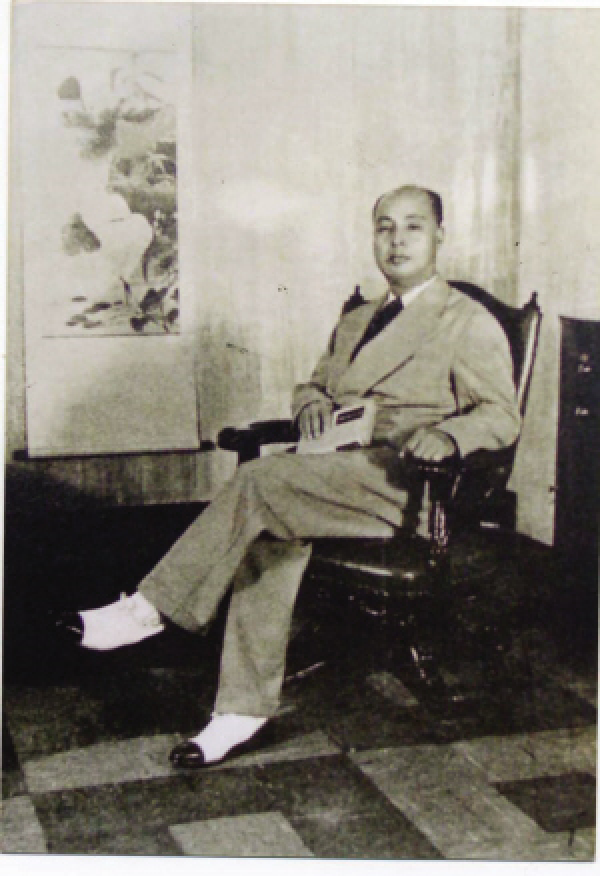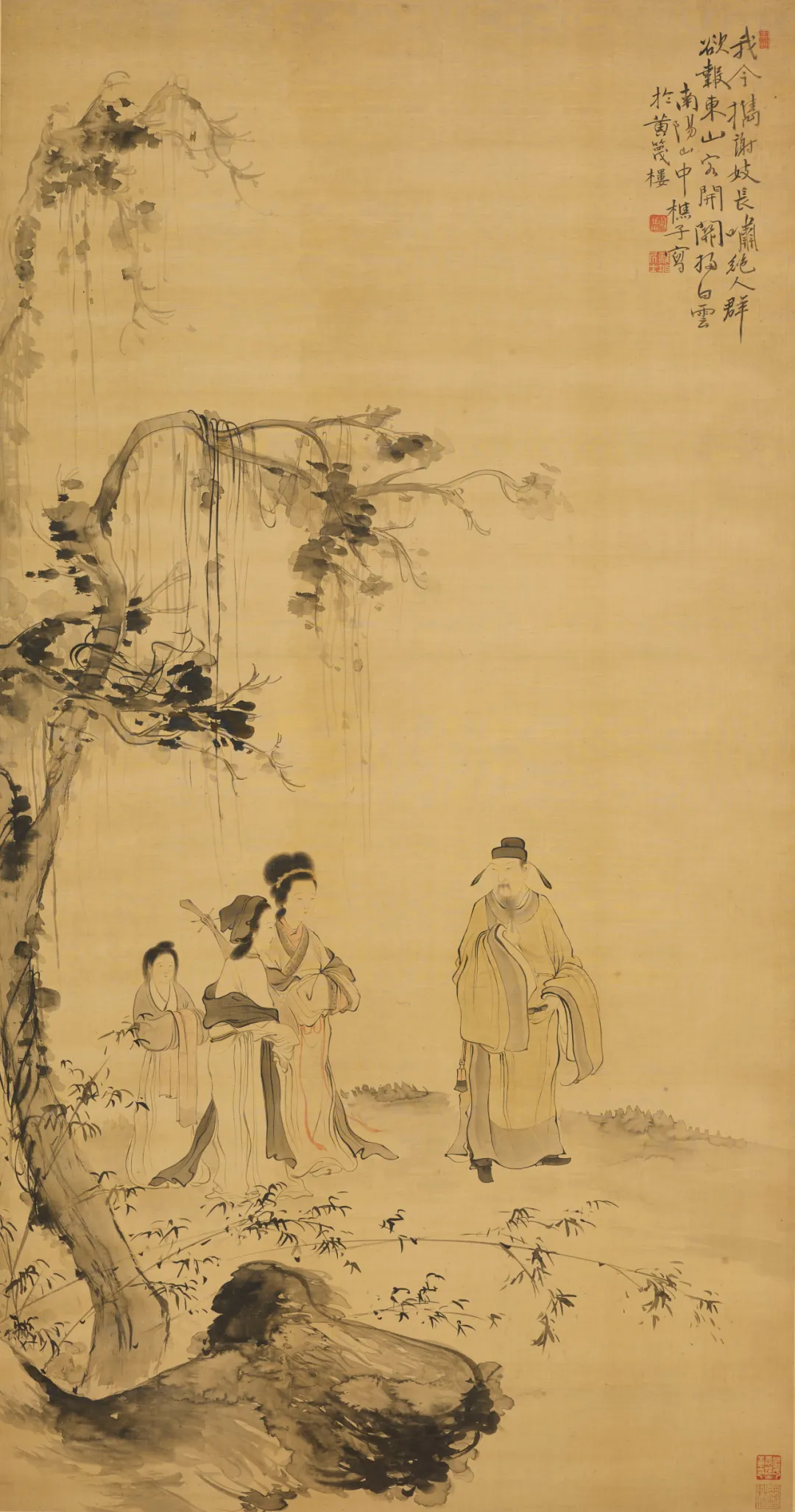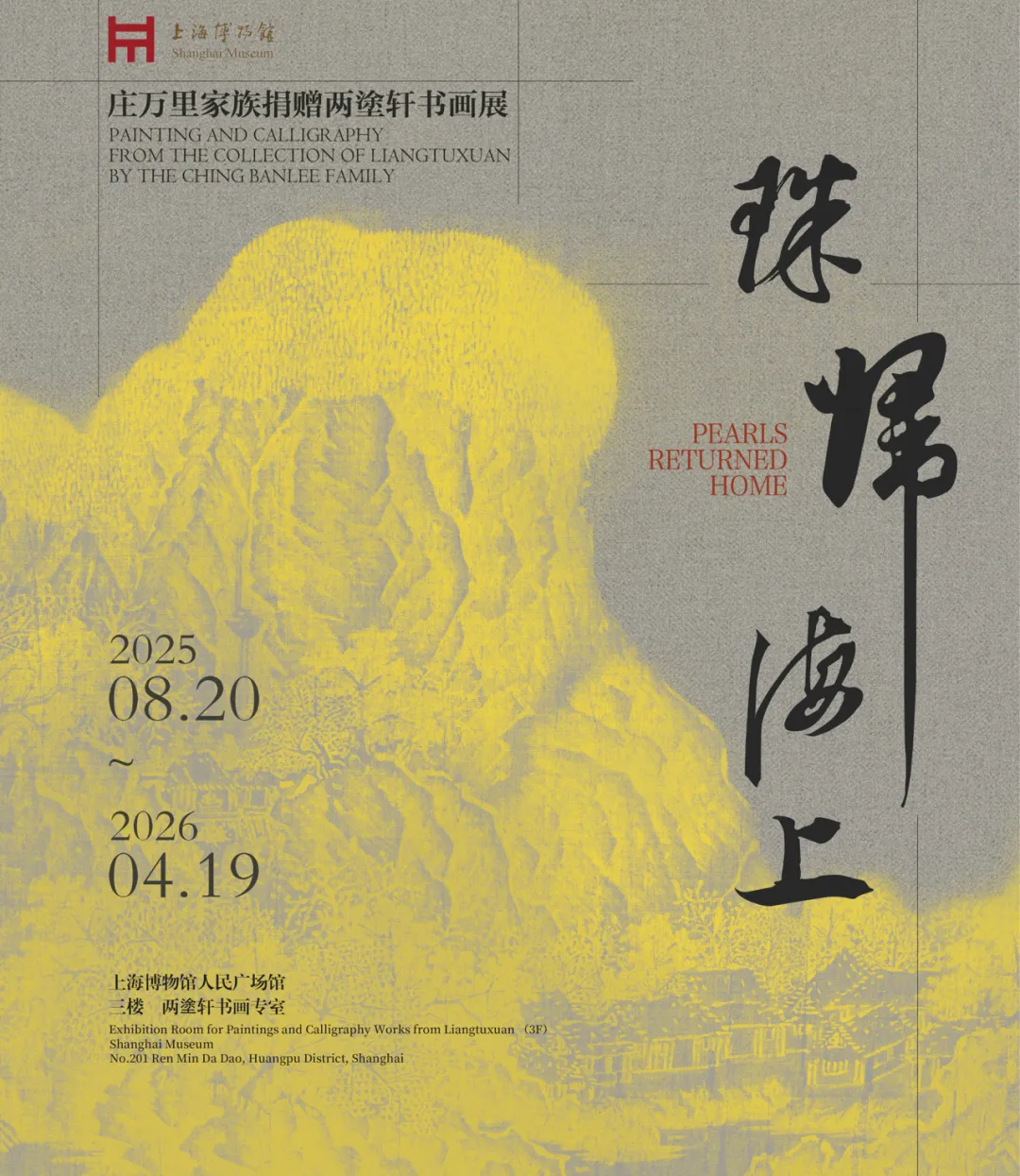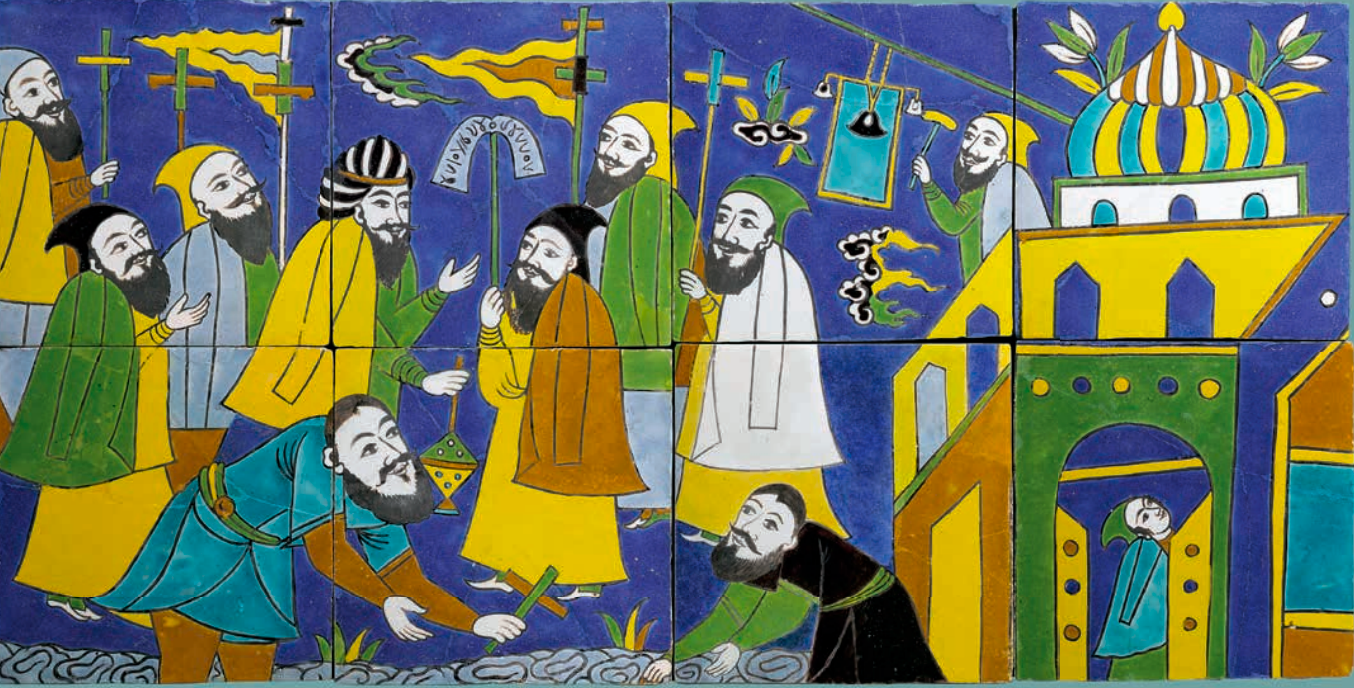
Among the Shanghai Museum's collection of ancient calligraphy and paintings, the "Liang Tu Xuan" collection, donated by Filipino-Chinese entrepreneur Zhuang Wanli (1899-1965), is a treasured treasure. The Paper reports that the "Pearls Return to the Sea: The Zhuang Wanli Family Donated Liang Tu Xuan Calligraphy and Painting Exhibition" will be held on the third floor of the Shanghai Museum's People's Square Gallery starting August 20th. The exhibition showcases the collection, donated by Zhuang Wanli, and showcases the newly renovated and expanded Liang Tu Xuan exhibition hall at the Shanghai Museum's People's Square Gallery. The exhibition includes works such as the Song Dynasty scroll "Autumn Mountain and Quiet Temple" and a scroll of nine Dong Qichang's running script handwritten letters.

On August 20, 2025, the Shanghai Museum officially opened its doors to the public with the exhibition "Pearls Return to the Sea: The Zhuang Wanli Family Donated the Liang Tu Xuan Collection of Calligraphy and Painting." The history and development of the Shanghai Museum are inextricably linked to the generosity of numerous donors. Among the museum's collections, the Liang Tu Xuan collection, donated by Filipino-Chinese entrepreneur Zhuang Wanli (1899–1965), is particularly valuable. This marked the first such donation of such a significant number of precious cultural relics by a non-Chinese person to a national museum in China. The Shanghai Museum has dedicated a dedicated room dedicated to the Liang Tu Xuan collection to honor the Zhuang family's dedication and generosity in preserving Chinese culture. The room is located on the third floor of the Shanghai Museum's People's Square Pavilion. The exhibition will run until April 19, 2026.

Liangtuxuan Calligraphy and Painting Studio

Mr. Zhuang Wanli at his 50th birthday (Photo source: "The Liangtuxuan Calligraphy and Painting Collection Donated by the Zhuang Wanli Family to the Shanghai Museum")
Chu Xiaobo, Director of the Shanghai Museum, stated that with the completion of the Shanghai Museum's East Building, the "Liang Tu Xuan" exhibition hall within the People's Square building has been renovated and upgraded, expanding its exhibition offerings. This time, based on a thorough review and research of the collection, we will present the "Liang Tu Xuan" collection of calligraphy and paintings in a more comprehensive and systematic manner. Sharing these donated art treasures with the public is both the Zhuang family's wish and an honor for the Shanghai Museum.
Ms. Zhuang Liangyou, daughter of Mr. Zhuang Wanli, a family member of the donor, also visited the exhibition today. Seeing the familiar family-donated paintings and calligraphy on display in the "Liang Tu Xuan" exhibition room was deeply moving. She recalled, "My father had a heart attack and was unable to speak. He cried constantly. I knew he was worried about these paintings and calligraphy, so I took good care of them for him." These paintings and calligraphy later became part of the Shanghai Museum's collection. Zhuang Wanli's children, carrying forward their father's wishes, generously selected 233 exquisite pieces and donated them to the Shanghai Museum in 2000. The "Liang Tu Xuan" collection has since returned to the sea.
Ms. Zhuang Liangyou said that she was very happy and grateful to the leadership of the Shanghai Museum. After the renovation and upgrading of the "Liang Tu Xuan" exhibition hall, more of her father's old collections can be exhibited, presenting a more comprehensive picture of her father's collection.

The donor's family and Ms. Zhuang Liangyou (third from left) visited the "Liang Tu Xuan Calligraphy and Painting Exhibition" accompanied by Shanghai Museum staff
According to reports, all scrolls at the "Liang Tu Xuan" collection have been meticulously examined and authenticated by experts including Qi Gong, Liu Jiuan, Yang Renkai, Fu Xinian, Zhong Yinlan, and Shan Guolin. The collection boasts a rich collection of calligraphy and paintings, spanning over 800 years, from the Song Dynasty to the Ming, Qing, and modern times. The collection encompasses a wide range of genres, including figures, landscapes, flowers and birds, and calligraphy. The collection features masterpieces by renowned artists, many of which possess multifaceted artistic and humanistic value.

Exhibition view of the scroll "Autumn Mountain and Quiet Temple" by an anonymous artist from the Song Dynasty
The majority of these paintings and calligraphy were acquired from Japan by Mr. Zhuang Wanli, a Chinese-American. This collection of precious Ming and Qing dynasty paintings and calligraphy spans a wide range of time periods and encompasses a wide range of subject matter. Some of the artists' works even fill gaps in museum collections. For example, the anonymous Song dynasty scroll "Autumn Mountain and Quiet Temple" is a significant work in the style of Fan Kuan, a work between the Northern and Southern Song dynasties, and it fills a gap in the Shanghai Museum's collection. "Authentic works by Fan Kuan are rare, with the exception of 'Traveling in Mountains and Rivers.' There are also only a handful of surviving works by contemporary artists that imitate Fan Kuan's style. This is the only example in the Shanghai Museum's collection that embodies his style. It was passed down through the hands of Gao Shiqi, a renowned Qing dynasty collector. It bears an inscription by Wang Duo, and the modern and contemporary calligrapher and painter Wu Hufan also studied this work," said Ling Lizhong, Director of the Shanghai Museum's Painting and Calligraphy Research Department.
From these dazzling array of Chinese Ming and Qing dynasty calligraphy and painting works in Japan, we can also glimpse the tremendous influence of Chinese art since the Ming and Qing dynasties on Japan's Muromachi period, Edo period, and modern and contemporary art trends and aesthetic tastes, as well as information on the mutual influence between Japanese art and modern and contemporary Chinese art.
Sun Danyan, associate researcher at the Shanghai Museum's Painting and Calligraphy Research Department, stated that Mr. Zhuang Wanli's collection of calligraphy and paintings is exceptional in both precision and breadth. Each piece he donated is exquisite, representing a classic or representative example of his style, a testament to the precision of his collection. In terms of breadth, his collection of calligraphy and paintings encompasses a comprehensive range of styles and schools throughout the history of calligraphy and painting, with his collection of figure paintings and calligraphy from the late Ming Dynasty being particularly outstanding.
Previously, the "Liang Tu Xuan" room served as a gallery within the Shanghai Museum's (People's Square) Painting Gallery. Due to space limitations, it could only display around 20 works per exhibition. This exhibition features a total of 41 works, which will be rotated every six months. Works not currently on display will also be presented in subsequent exhibitions.
There are many exquisite works of figure painting
Among the paintings in the Liangtuxuan collection, figure paintings are particularly exquisite. The Ming Dynasty anonymous work, "Eighteen Scholars Screen," depicts the figures' movements and expressions with meticulous line drawing, rich, ancient colors, and inherits the tradition of Song Dynasty meticulous brushwork and heavy color painting, demonstrating a mastery of exceptional artistry, unmatched by ordinary artists. The artist's signature has been lost, and later generations have falsely added the "Tang Yin" seal. However, compared to surviving works by Du Jin, such as "Playing with Antiques," "Ancient Sages and Poems," and "Hengqin Under the Plum Tree," experts at the Shanghai Museum believe this screen is likely by Du Jin. Du Jin's surviving works are few and far between, making them all the more precious.
Two anonymous Ming Dynasty paintings, "Listening to the Waterfall Under a Pine Tree" and "Fisherman Asking for the Way," inscribed "Xiaoxian" and bearing the seal "Wu Wei," clearly inherit the style of Wu Wei, the master of the mid-Ming Jiangxia School, though with a sharper and more swift brushstroke. A closer examination of the technique reveals similarities to the style of Wu Si'en, a later disciple of the Zhejiang School. Experts at the Shanghai Museum believe that these two paintings are likely the work of Wu Si'en. While not Wu Wei's, they are rare examples of works by later followers of the Jiangxia School.

Listening to the Waterfall Under a Pine Tree, Ming Dynasty, an anonymous work
Another example of the Zhejiang School of Painting is "Fishermen Singing at Dusk," a scroll believed to be an authentic work by Zhang Lu. Chen Hongshou, who pioneered an elegant and peculiar style in the late Ming Dynasty, created "Exploring Plum Blossoms" in his later years. "Dongshan with a Courtesan" is a scroll by Hua Yan, a renowned painter from the mid-Qing Dynasty, embodying the characteristic sparse brushwork of his figure painting in his later years.

Ming Dynasty Chen Hongshou's "Exploring Plum Blossoms" scroll

Qinghuayan's "Dongshan with a Prostitute" scroll
In addition, the works of Huang Shen, Min Zhen, Fei Danxu from the Qing Dynasty and modern master Qi Baishi allow viewers to appreciate the artistic style of each school.
There are many famous landscape, flower and bird paintings
Liang Tuxuan has a large collection of landscape paintings, many of which are works by famous artists.
The unsigned "Autumn Mountain and Quiet Temple Scroll" from the Song Dynasty is the earliest painting in the collection. It depicts a mountain temple in autumn, with withered vegetation. Its broad composition and solid brushwork evoke the style of Fan Kuan of the Northern Song Dynasty, while the delicate peaks and ridges, rendered in light ink, evoke the charm of the Southern Song Dynasty.

Anonymous Song Dynasty painting, "Autumn Mountain and Quiet Temple"
Xie Shichen, a renowned mid-Ming Dynasty landscape painter, has three large paintings. Lan Ying, a renowned late-Ming Zhejiang painter, has two works, one of which, "Landscape Scroll in the Style of Huang Gongwang," is a rare large-scale painting on paper.
Liangtuxuan houses authentic works of the "Four Wangs", leaders of the orthodox school of painting in the early Qing Dynasty. These include Wang Jian's "Landscape Painting in the Style of Chen Weiyun" and Wang Hui's "Farewell at the Stream Pavilion".

Landscape scroll in the style of Chen Weiyun by Wang Jian of the Qing Dynasty
Another distinctive feature of the Liangtuxuan collection of landscape paintings is the inclusion of works by lesser-known artists, such as Ge Zhengqi from the late Ming Dynasty, Wan Shanglin and Qi Zhijia from the early Qing Dynasty, and Fang Shishu, Huang Jun, Zhang Zhiwan, and Liu Yanchong from the mid-to-late Qing Dynasty. These painters were all trendsetters of various artistic trends at the time, and their works reflect the evolution and development of these schools of painting.
Liangtuxuan also boasts a significant collection of bird-and-flower paintings. Lin Liang's "Birds and Bamboo" from the Ming Dynasty is a rare masterpiece. Modern master Qi Baishi's "Seven Crowns Crying" is a truly remarkable work, a masterpiece of simple, lifelike sketching and vivid expression.

Ming Dynasty Lin Liang's "Bamboo and Birds Scroll"
The calligraphy of Ming and Qing dynasties was magnificent
Among the collections of Liangtuxuan, calligraphy is an important category, with a considerable number, exuding the refreshing fragrance of ink from famous calligraphers of the Ming and Qing dynasties.
Among the calligraphic works, Dong Qichang's "Nine Handwritten Notes in Running Script" is a masterpiece. These nine letters, which describe his interactions with fellow scholars and monks, his concerns about state affairs, and his expression of his anger at the slander of villains, provide valuable historical material for understanding Dong Qichang's life and thought. The calligraphy in these letters reflects his profound mastery of calligraphy at the height of his artistic career.

Part of a scroll of nine Ming Dynasty handwritten letters in running script by Dong Qichang
There are three works of Zhang Ruitu in the collection, among which the "Running Script Seven-Character Poem Scroll" was created in his later years and is very personal.

Ming Dynasty Zhang Ruitu's "Cursive Script Scroll of Geng Xuan's Early Morning Poems"
Wang Duo's "Five-Character Verse in Running Script" represents his mature calligraphy style. The whole piece is full of vigor and vitality, showing his superb artistic attainments.
The Qing Dynasty calligraphy works in the Liangtuxuan collection encompass a diverse range of styles. The works of Song Cao, Yongyan, Wang Wenzhi, and Liu Yong, among others, reflect the continued popularity of the calligraphy school. The Liangtuxuan collection also includes numerous works by prominent officials and historical figures, such as Ming Yi Wang Zhu Youbin (the sixth son of Emperor Xianzong), Zhan Jingfeng, and Wen Zhenmeng; Qing Dynasty masters Cha Shibiao, Gong Dingzi, Lu Runxiang, Shen Baozhen, Lin Zexu, Weng Tonghe, and Kang Youwei. The collection also includes works by lesser-known but highly skilled literati, providing additional material for the history of calligraphy.

Exhibition poster
Exhibition Name: Pearls Return to the Sea: Zhuang Wanli Family Donated Liang Tuxuan Calligraphy and Painting Exhibition
Exhibition time: August 20th - April 19th, 2026
Exhibition location: 3rd floor, People's Square, Shanghai Museum


